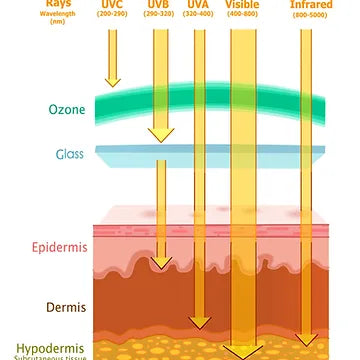The sun releases its energy in little packets of energy called photons. The photons have many different wavelengths. Some wavelengths produce heat, other wavelengths create visible light. Science traditionally taught us that the most damaging rays were in the invisible or ultraviolet wavelengths. The ultraviolet light spectrum is divided into UVB ultraviolet spectrum (the sunburn rays) and UVA (the tanning rays). Recent studies suggest that in fact at least 50% of the injury is a result of exposure to visible and infrared light (32).This is an important change in our thinking because sunscreens are designed to protect us only from UVB sun burns and most of UVA. The spectrum of action in Topical Vitamins covers the entire spectrum - UVB, UVA, infrared, and visible light.
When photons reach the skin’s surface they enter the skin. When the energy of that photon hits a skin structure a chemical reaction occurs, releasing free radicals. These are highly energized molecules which damage the cell. When free radicals strike DNA, a structural change occurs which may eventually lead to skin cancer. When photons hit collagen fibers, the free radicals attack the collagen and break the collagen strands producing lines and wrinkles. Free radicals cause the epidermal and pigment changes Actinic lentigo. Every day in the sun we absorb millions of photons of light. These photons may be absorbed by melanin; neutralized by antioxidants or are free to cause random damage. The scientific names can become confusing. The molecules in skin that neutralize free radicals are called antioxidants.

